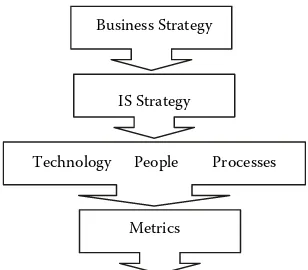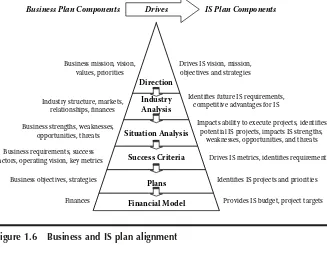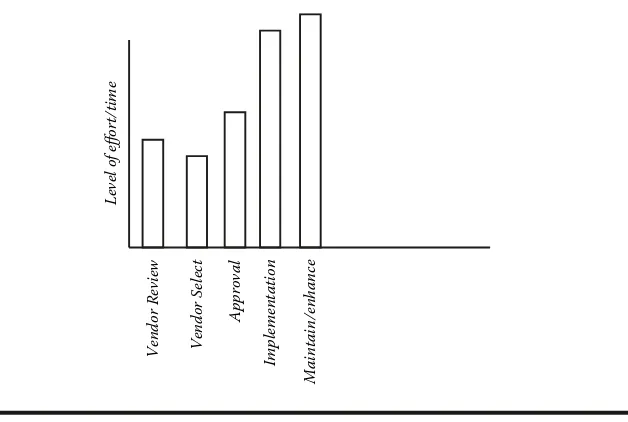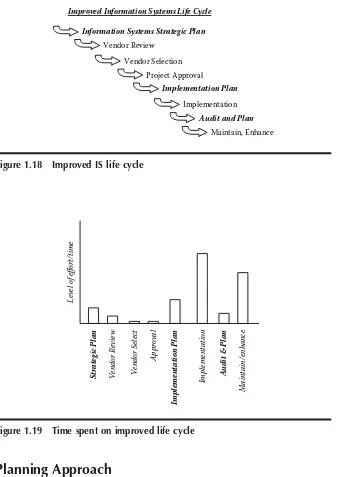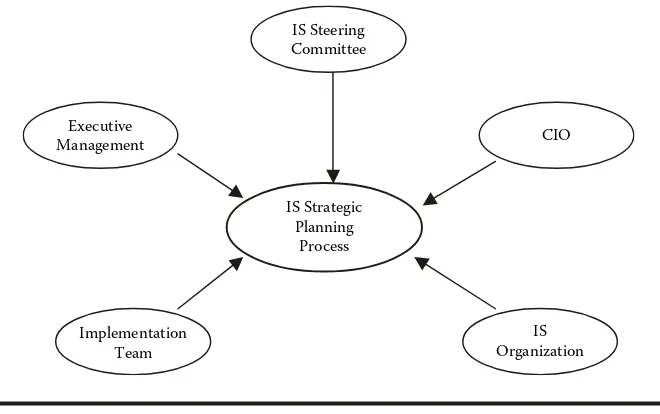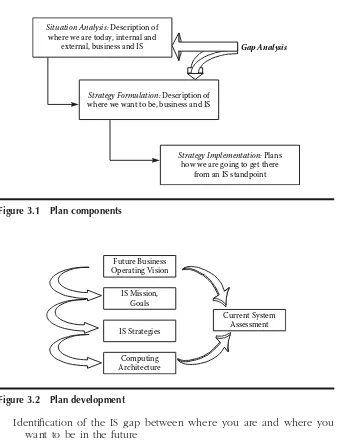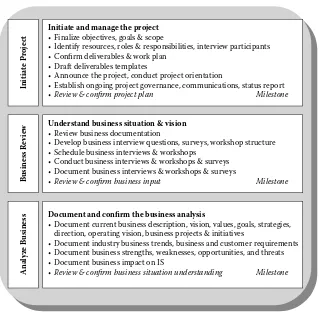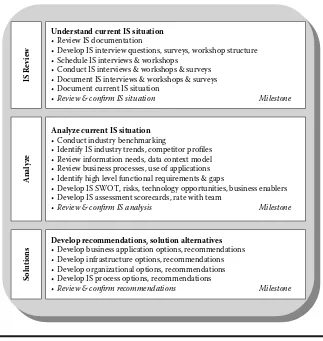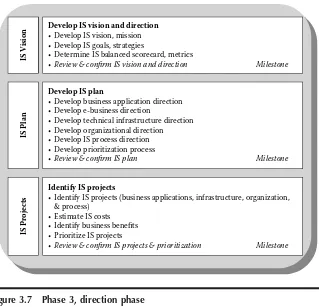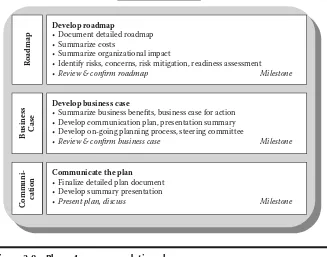Information
Systems
Strategic
Planning
AUERBACH PUBLICATIONS www.auerbach-publications.com
To Order Call: 1-800-272-7737 • Fax: 1-800-374-3401 E-mail: [email protected]
Agent-Based Manufacturing and Control Systems: New Agile Manufacturing Solutions for Achieving Peak Performance Massimo Paolucci and Roberto Sacile ISBN: 1574443364
Curing the Patch Management Headache Felicia M. Nicastro
ISBN: 0849328543
Cyber Crime Investigator's Field Guide, Second Edition
Bruce Middleton ISBN: 0849327687
Disassembly Modeling for Assembly, Maintenance, Reuse and Recycling A. J. D. Lambert and Surendra M. Gupta ISBN: 1574443348
The Ethical Hack: A Framework for Business Value Penetration Testing James S. Tiller
ISBN: 084931609X
Fundamentals of DSL Technology Philip Golden, Herve Dedieu, and Krista Jacobsen ISBN: 0849319137
The HIPAA Program Reference Handbook Ross Leo
ISBN: 0849322111
Implementing the IT Balanced Scorecard: Aligning IT with Corporate Strategy Jessica Keyes
ISBN: 0849326214
Information Security Fundamentals Thomas R. Peltier, Justin Peltier, and John A. Blackley
ISBN: 0849319579
Information Security Management Handbook, Fifth Edition, Volume 2 Harold F. Tipton and Micki Krause ISBN: 0849332109
Introduction to Management of Reverse Logistics and Closed Loop Supply Chain Processes Donald F. Blumberg
ISBN: 1574443607
Maximizing ROI on Software Development Vijay Sikka
ISBN: 0849323126
Mobile Computing Handbook Imad Mahgoub and Mohammad Ilyas ISBN: 0849319714 Borko Furht and Darko Kirovski ISBN: 0849327733
Network Design: Management and Technical Perspectives, Second Edition Teresa C. Piliouras Offshore: Making It Work
Tandy Gold ISBN: 0849319439
Quality Management Systems: A Handbook for Product Development Organizations Vivek Nanda
ISBN: 1574443526
A Practical Guide to Security Assessments
Software Testing and Continuous Quality Improvement,
Second Edition William E. Lewis ISBN: 0849325242
Supply Chain Architecture:
A Blueprint for Networking the Flow of Material, Information, and Cash William T. Walker
ISBN: 1574443577
The Windows Serial Port Programming Handbook Ying Bai
Boca Raton New York
Information
Systems
Strategic
Planning
By
Anita Cassidy
6000 Broken Sound Parkway NW, Suite 300 Boca Raton, FL 33487-2742
© 2006 by Taylor & Francis Group, LLC Auerbach is an imprint of Taylor & Francis Group
No claim to original U.S. Government works
Printed in the United States of America on acid-free paper 10 9 8 7 6 5 4 3 2 1
International Standard Book Number-10: 0-8493-5073-5 (Hardcover) International Standard Book Number-13: 978-0-8493-5073-3 (Hardcover) Library of Congress Card Number 2005050533
This book contains information obtained from authentic and highly regarded sources. Reprinted material is quoted with permission, and sources are indicated. A wide variety of references are listed. Reasonable efforts have been made to publish reliable data and information, but the author and the publisher cannot assume responsibility for the validity of all materials or for the consequences of their use.
No part of this book may be reprinted, reproduced, transmitted, or utilized in any form by any electronic, mechanical, or other means, now known or hereafter invented, including photocopying, microfilming, and recording, or in any information storage or retrieval system, without written permission from the publishers.
For permission to photocopy or use material electronically from this work, please access www.copyright.com (http://www.copyright.com/) or contact the Copyright Clearance Center, Inc. (CCC) 222 Rosewood Drive, Danvers, MA 01923, 978-750-8400. CCC is a not-for-profit organization that provides licenses and registration for a variety of users. For organizations that have been granted a photocopy license by the CCC, a separate system of payment has been arranged.
Trademark Notice: Product or corporate names may be trademarks or registered trademarks, and are used only for identification and explanation without intent to infringe.
Library of Congress Cataloging-in-Publication Data
Cassidy, Anita.
A practical guide to information systems strategic planning / Anita Cassidy.-- 2nd ed. p. cm.
Includes bibliographical references and index. ISBN 0-8493-5073-5 (alk. paper)
1. Information technology--Management--Planning. 2. Strategic planning. I. Title.
HD30.2.C395 2005
658.4'038--dc22 2005050533
Visit the Taylor & Francis Web site at http://www.taylorandfrancis.com
and the Auerbach Publications Web site at http://www.auerbach-publications.com Taylor & Francis Group
v
Contents
Pr eface ... xi
Acknowledgments ... xv
About the Author ... xvii
1
Purpose of Infor mation Systems Strategic Planning ... 1Benefits of IS Planning... 4
Effective Management of an Expensive and Critical Asset to the Organization ... 5
Improving Communication and the Relationship between the Business and IS Organization ... 6
Aligning the IS Direction and Priorities to the Business Direction and Priorities ... 7
Operational Excellence ... 10
Customer Intimacy ... 11
Product Leadership ... 12
Identifying Opportunities to Use Technology for a Competitive Advantage and Increase the Value to the Business... 14
Planning the Flow of Information and Processes... 15
Efficiently and Effectively Allocating IS Resources ... 16
Reducing the Effort and Money Required Throughout the Life Cycle of Systems ... 17
Planning Approach ... 19
Conclusion ... 21
Notes for My IS Strategic Planning Project... 22
References... 22
2
IS Governance ... 23Definition of Governance... 23
Importance of Governance ... 24
Approaches to Governance ... 27
Involvement of the Organization... 29
IS Steering Committee ... 31
CIO... 34
IS Organization... 35
Implementation Team... 36
Conclusion ... 37
Notes for My IS Strategic Planning Project... 38
References... 38
3
The Planning Pr ocess ... 39Planning Components... 39
Planning Process ... 41
Phase 1: Visioning... 41
Phase 2: Analysis... 44
Phase 3: Direction... 44
Phase 4: Recommendation ... 46
Plan Contents ... 47
Plan Development ... 48
Conclusion ... 51
Notes for My IS Strategic Planning Project... 51
4
The Visioning Phase ... 53Initiate and Manage the Project... 53
Finalize Objectives, Goals, and Scope ... 54
Scope... 59
Identify Resources, Roles, and Responsibilities; Interview Participants... 63
Confirm Deliverables and Work Plan... 65
Draft Deliverable Templates... 65
Announce the Project; Conduct Project Orientation... 65
Establish Ongoing Project Governance, Communications, and Status Report ... 66
Review and Confirm Project Plan (Milestone) ... 66
Understand the Business Situation and Vision... 67
Review Business Documentation... 68
Develop Business Interview Questions, Surveys, and Workshop Structure ... 70
Surveys ... 72
Schedule Business Interviews and Workshops... 79
Conduct Business Interviews, Workshops, and Surveys... 80
Document Business Interviews, Workshops, and Surveys ... 80
Review and Confirm Business Input... 81
Document and Confirm the Business Analysis ... 81
Document Current Business Description, Vision, Values, Goals, Strategies, Direction, Operating Vision, Business Projects, and Initiatives... 81
Global Requirements... 84
Document Industry Business Trends, Business, and Customer Requirements ... 87
Environmental Business Requirements... 87
External Business Requirements ... 88
Value Chain Analysis... 90
Business Measures... 91
Business Processes ... 94
Business Requirements ... 100
Document Business Strengths, Weaknesses, Opportunities, and Threats... 101
Document Business Impact on IS ... 102
Review and Confirm Business Situation Understanding... 119
Conclusion ... 119
Notes for My IS Strategic Planning Project... 120
5
The Analysis Phase ... 121Understanding the Current IS Situation ... 121
Review IS Documentation ... 121
Develop IS Interview Questions, Surveys, and Workshop Structure ... 130
Surveys ... 132
Schedule IS Interviews and Workshops... 135
Conduct IS Interviews, Workshops, and Surveys... 135
Document IS Interviews, Workshops, and Surveys ... 136
Document the Current IS Situation ... 136
Business Application Environment ... 138
Desktop Environment ... 144
Server Environment... 153
Network Environment... 160
Telecommunications Environment ... 160
Data Center Environment ... 161
IS Organization... 162
Project Workload (Current and Backlog) ... 167
Processes... 173
Budget and Metrics ... 178
Review and Confirm IS Situation... 178
Analyzing the Current IS Situation ... 178
Conduct Industry Benchmarking ... 179
Identify IS Industry Trends and Competitor Profiles ... 179
Competitor Profiles ... 185
Review Information Needs and Data Context Model ... 186
Review Business Processes and Use of Applications ... 187
Identify High-Level Functional Requirements and Gaps ... 187
Business Requirements Analysis ... 187
Environmental Business Requirements Analysis... 193
External Business Requirements Analysis ... 194
Business Strengths, Weaknesses, Opportunities, and Threats Analysis ... 194
Develop IS Strengths, Weaknesses, Opportunities, Threats (SWOT), Risks, Technology Opportunities, Business Enablers... 194
Develop IS Assessment Scorecards; Rate with Team ... 203
Review and Confirm IS Analysis ... 214
Developing Recommendations and Solution Alternatives... 214
Develop Business Application Options and Recommendations ... 214
Develop Infrastructure Options and Recommendations... 215
Develop Organizational Options and Recommendations... 216
Develop IS Process Options and Recommendations... 217
Review and Confirm Recommendations ... 218
Conclusion ... 218
Notes for My IS Strategic Planning Project... 219
References... 220
6
The Direction Phase ... 221Developing the IS Vision and Direction... 222
Developing the IS Vision and Mission... 222
Vision ... 224
Mission ... 227
Values ... 230
Develop the IS Goals and Strategies... 230
Goals ... 230
Strategies ... 235
Determine the IS Balanced Scorecard and Metrics... 245
Review and Confirm the IS Vision and Direction ... 249
Developing the IS Plan ... 249
Develop the Business Application Direction... 249
Information Architecture... 259
Develop the E-Business Direction... 260
Develop the Technical Infrastructure Direction ... 266
Develop the Organizational Direction ... 272
Develop IS Process Direction ... 283
Develop a Prioritization Process... 286
Prioritizing by Business Objective ... 288
Prioritizing by Forced Ranking ... 289
Prioritizing by Business Performance Impact Criteria... 290
Review and Confirm the IS Plan ... 290
Identifying IS Projects... 290
Estimate IS Costs ... 293
Identify Business Benefits ... 293
Prioritize IS Projects ... 294
Review and Confirm the IS Projects and Prioritization ... 294
Conclusion ... 295
7
The Recommendation Phase ... 297Develop a Road Map ... 298
Document a Detailed Road Map ... 298
Summarize Costs ... 298
Summarize Organization Impact... 303
Identify Risks, Concerns, Risk Mitigation, and Readiness Assessment... 304
Review and Confirm Road Map ... 315
Develop a Business Case ... 315
Summarize Business Benefits and a Business Case for Action ... 315
Develop a Communication Plan and Presentation Summary ... 321
Develop an Ongoing Planning Process and Steering Committee ... 322
Review and Confirm the Business Case ... 323
Communicate the Plan ... 323
Finalize the Detailed Plan Document ... 323
Develop the Summary Presentation ... 329
Present the Plan and Discuss It... 330
Conclusion ... 331
Notes for My IS Strategic Planning Project... 332
8
Next Steps ... 333Marketing ... 333
Executing ... 335
Project Plan... 335
Project Kick-Off Meeting ... 339
Request for Quote... 340
RFQ Response Review... 344
Software Demonstrations... 349
Vendor Selection ... 352
Managing ... 352
Measuring ... 357
Conclusion ... 357
Notes for My IS Strategic Planning Project... 358
xi
Preface
The second revision of this book reflects the continual changes and advances in technology, and provides improvements and additional detail in the planning methodology. The process outlined in this book has been enhanced from lessons learned by using the methodology in various companies, cultures, and environments. Additional details, examples, and templates are included to help guide your planning process.
Many organizations today continue to experience increasing informa-tion systems (IS) costs. In addiinforma-tion to increasing costs, organizainforma-tions are finding their IS to be a bottleneck to business improvements and growth. These organizations are assessing their IS and asking basic yet tough questions, such as:
䡲 Are we obtaining true value from the investments in IS?
䡲 Are the current IS applications meeting the business needs?
䡲 Are we working on the right IS projects to provide the most value
to the business?
䡲 Will our current applications meet business requirements in the
future?
䡲 What IS mission, objectives, strategies and computing architectures
are necessary to meet the business challenges of the future?
companies that have gained a competitive edge have effectively invested in IS initiatives. A properly planned IS direction is a critical component for an organization’s success.
Following the process outlined in this book will improve communica-tion between business management and the IS funccommunica-tion. Often, business management does not have a good understanding of the IS function and might have questions such as:
䡲 What is our current IS environment? What computers and software
do we use to manage the business? What is the condition of our IS environment? What are the strengths, weaknesses, and areas of vulnerability of our IS environment? Do the IS and associated processes help us facilitate the delivery of services and products to our customers in the most cost-efficient and effective manner?
䡲 How can we make the best decisions about our IS investments?
What should be our investment priorities?
䡲 What is our IS resources currently working on? How do the IS
employees spend their time? How does the size of our IS organi-zation compare with the industry?
䡲 How much money is the company spending on IS? How does our
IS spending compare to the industry? How much has the spending grown over the past few years? We have been doing well without substantially increasing spending, so why do we need to spend more now? How can we decrease our spending on IS, or spend our money more wisely?
䡲 What are the industry technology trends, and how do the industry
trends affect us?
䡲 What is the status of our competitors’ IS? Is our company behind
or ahead of our competitors?
䡲 Do we have the internal skills necessary to take the environment
where it needs to be? How much can we do with internal resources, and how much should we utilize external resources? Why does it take so long to get things done?
Similarly, IS management may not have a thorough understanding of the business direction and might have questions such as:
䡲 What are the business mission, objectives, and strategies?
䡲 What type of business will the company be in during the next few
years?
䡲 How does the business want to function in the future?
䡲 What are the key information needs?
䡲 What are our customers and suppliers demanding of us?
䡲 Are there any IS issues constraining the business?
An effective IS strategic planning process can answer all these questions and provide a communication vehicle between the IS function and busi-ness management.
The foundation of the process outlined in this book is that the business direction and business requirements must drive the IS direction and computing architecture. Although this sounds like a basic concept, many organizations will actually reverse the concept and let the attractive new technology drive their direction. In actuality, these organizations end up looking for a business problem to solve with the technology they want to utilize. This book will outline a systematic approach to guide you through the process of developing a solid IS plan that is formulated from the business plan. Even if your organization lacks a defined business plan, the approach in this book steps you through a fact-gathering process to obtain the necessary information regarding the business direction.
Although IS planning is critical, many organizations spend too much time and money in the planning process, complete the plan in isolation, or skip the planning process altogether. This can result in overanalysis, an inability to obtain approval of the plan, or the spending of millions of dollars solving the wrong problem. Many companies mistake a proper IS strategic planning process as something that must take many months (or even years) and thousands (or even millions) of dollars. However, with a solid process and methodology in place, you can complete the planning process with your own internal resources in a matter of weeks or a few months.
This book will outline a quick and easy approach to completing a thorough plan. It will also provide a set of concepts, techniques, and templates for analyzing, organizing, and communicating the information in the IS strategic plan. The process described will assist the organization with a collaborative effort that will result in a solid direction that has the support of the entire organization. Through the process, you will have a plan that will sell itself to management and others who need to approve the necessary investment.
The book provides a step-by-step process for developing a strategic plan. Modify the process to fit your particular needs, organization, and culture. The following explains the organization of the book:
䡲 The first chapter of the book provides background to the purpose
of an IS strategic plan.
䡲 Chapter 2 discusses a framework for the governance process that
䡲 The third chapter provides an overview of the four phases of the planning process.
䡲 Chapter 4 through 7 review each of the four phases of the planning
process, including visioning, analysis, direction, and recommenda-tion.
䡲 Chapter 8 outlines what to do next and how to make planning an
ongoing process.
This book is intended for both IS executives and consultants as well as business executives interested in improving their IS environment and utilizing IS as a competitive advantage. If your IS function is an integral part of the business and well connected with the business plans and direction, portions of this planning process will go quickly. For companies without a solid business plan or companies without aligned IS, the process will outline a systematic approach to determining and documenting the business direction so that it can be the foundation for the IS direction. Although this book presents developing an IS strategy as a formal project, CIOs may choose to handle much of what is included as part of their everyday organizational listening and ongoing planning process.
xv
Acknowledgments
Without the support of my family and friends, this book would not have been possible.
First, I would like to thank my husband Dan for his assistance on this book. With Dan’s 28 years of experience in IS, his insight and comments have been of tremendous value in writing this book. His continual support, understanding, patience, and encouragement are astounding. I would also like to thank my sons, Mike and Ryan, for giving me something to worry about, think about, and focus on besides this book. As they enter college and choose a profession, I hope that they are fortunate enough to land in a career that is their true passion. Of course, my mother, Randie Ekenberg, continues to be an inspiration, providing love and support. Thanks also goes to my friend Stephanie Renslow for keeping me on target by periodically asking “Are you done yet?”
xvii
About the Author
Anita Cassidy has over 27 years of experience in IS. She has served as director, vice president, and CIO at worldwide manufacturing companies. For the past seven years, Cassidy has been founder and CEO of a consulting organization, Strategic Computing Directions Inc., in Minne-apolis, Minnesota. Strategic Computing Directions (http:// www.strate-giccomputing.com) specializes in executive IS management consulting in the areas of:
䡲 Strategic planning
䡲 IS assessment
䡲 E-business strategy
䡲 Interim and advisory CIO
䡲 IS process improvement
䡲 Software selection
Cassidy has personally completed over 40 IS strategic plans and assess-ments for companies of all sizes and in a variety of industries. She has published articles in national magazines, is a writer for a technology research company, and is a national speaker on IS strategic planning. In
addition to A Practical Guide to Information Systems Strategic Planning,
Cassidy has authored the following books, published by St. Lucie Press:
䡲 A Practical Guide to Information Systems Process Improvement
(2000), with Keith Guggenberger
䡲 A Practical Guide to Planning for E-Business Success (2002)
Cassidy has a BS degree from the University of Minnesota and also attended St. Cloud State University. She can be reached at:
1
Purpose of
Information Systems
Strategic Planning
He who is outside his door already has a hard part of his journey behind him.
— Dutch pr overb
The word “strategy” is often misused. In some circles, it is synonymous with “important.” In this book, “strategy” refers to a global level of thinking about the information systems (IS) organization and its integration with the rest of the enterprise. A strategy must be coherent, consistent, and
directional. Coherent means it is clear to both the business and IS
orga-nization. Consistent means that it is constructed to fit together. Directional
means it directs changes of some kind. Strategies do not merely endorse the status quo.
action for achieving the envisioned changes. Often, the strategic planning effort results in a book on the shelf. To be effective, implement strategic planning as an ongoing process to ensure it keeps current as business and technology changes.
Why do we need to complete strategic planning for the IS function? What is the purpose of the planning process? The planning process enables IS to help the organization meet its business objectives. The IS strategic planning process may be initiated in an organization for a variety of reasons. Some examples include:
䡲 A recently acquired company initiated the planning process to
determine how to meld the systems and processes of two previ-ously separate organizations. Business management viewed the application systems and processes as critical vehicles for providing customers with a common face for the new organization. In addi-tion, executive management wanted to obtain consistent informa-tion to manage the newly merged company as one organizainforma-tion. The new business also saw an opportunity to leverage synergies and reduce overhead costs of the previously separate organizations.
䡲 A small and growing company was experiencing severe quality
problems and found that the company was losing its competitive edge in the marketplace. In the past, the company had very favorable statistics and key indicators (such as sales, inventory turns, days sales outstanding, and profits) relative to the competi-tion. The company was gradually falling behind the industry as sales and profits were on a downward trend. Management viewed IS applications as a major roadblock to improving the quality, business processes, and key measurements. Executive management initiated the planning process to review the business application systems available on the market to determine the best direction.
䡲 A newly hired vice president of IS in a government agency initiated
a strategic planning process to assess the current IS situation. The planning process gave the new leader an opportunity to provide input into the direction and create a vision of IS for the future.
䡲 In another company, the business departments were frustrated with
䡲 A manufacturing division of a large worldwide organization was under pressure to implement a particular vendor-supplied appli-cation package selected by the corporate division of the company. The manufacturing division was not directly involved in the selec-tion of the software and felt the package would probably not be the best fit for the unique business requirements of the division. Divisional executive management initiated the IS strategic planning process to determine the best solution rather than simply following the desired corporate direction.
䡲 One company faced the common problem of a growing and
endless backlog of IS projects. This company began the IS strategic planning process to prioritize the projects and align the IS priorities with the business priorities. The IS department also wanted to determine if it should continue to build upon and invest in the current systems or start over with a new set of business applica-tions.
䡲 A company faced the unpleasant task of downsizing. Executive
management initiated the IS strategic planning process to determine ways to reduce costs and gain efficiencies. Management wanted to evaluate the possibility of leveraging or consolidating multiple data centers and differing business applications to reduce costs while still meeting the business needs.
䡲 A high-growth company restructured its business to operate on a
worldwide basis. Previously, the company functioned on a geo-graphic basis from both a business accountability standpoint as well as having unique IS in each geographic area. Management began the IS planning process to determine how to bring the information together so that it could manage the new worldwide business.
䡲 An organization had completed a business planning process to
determine and document its business vision, mission, and objec-tives. Management began the IS strategic planning process to develop an IS strategy and direction aligned with the organization’s newly stated business direction.
䡲 A company let its IS grow over time without a plan in place. After
Benefits of IS Planning
Although the reasons driving the development of an IS strategic plan may be different, there are similarities in the benefits of a plan. There is more value and benefit in the strategic planning function than many other IS responsibilities, as shown in Figure 1.1. The benefits of IS strategic plans include:
䡲 Effective management of an expensive and critical asset of the
organization
䡲 Improving communication and the relationship between the
busi-ness and IS organization
䡲 Aligning the IS direction and priorities to the business direction
and priorities
䡲 Identifying opportunities to use technology for a competitive
advantage and increase the value to the business
䡲 Planning the flow of information and processes
䡲 Efficiently and effectively allocating IS resources
䡲 Reducing the effort and money required throughout the life cycle
of systems
Each of these benefits is discussed in more detail below.
Figure 1.1 IS responsibilities Value to the Business
• IS strategic planning • Prioritization • Portfolio management • Program management • Project management
• Business process re-engineering • Analysis and design
Effective Management of an Expensive and Critical Asset
to the Organization
A strategic plan is a key component to the success of any IS function and an important factor in assisting a company in meeting its business objec-tives, as shown in Figure 1.2. However, business management may view IS as a necessary evil rather than as a critical business function. Many times this is because business management does not understand the function and there is a lack of communication. IS may be slow to change, hampering the business, or out of line with the business direction. If this is happening in an organization, it may even be difficult for the IS department to schedule time with executive management for a presenta-tion. Why should management take the time to understand IS if it is not in touch with the business? Management may not even realize the potential benefits and opportunities that IS can offer to help meet business objec-tives.
For any company, IS are an expensive asset. If the company invested the same amount of money in a building, each member of management would know the location, age, and purpose of the building. Many com-panies spend more money on their IS, yet business management may not know as much about their systems as they do about their building! Similarly, a manufacturing company always knows the unit cost of the products manufactured and the drivers of the costs, and understands how to manage the costs.
Does management know how much money the company is spending on IS? Do managers realize how much each business application is costing
Figure 1.2 IS plan critical for the business BusinessPlan
Bu
sines
s Goals & Obje
ct
iv es Info
rma
tion System s P
and if they are worth maintaining? Do they know the cost per e-mail, the cost per help desk call, and the cost per server? What is the company really getting for its investment, and will the systems meet the company’s needs in the future? Do managers know the level of service quality and responsiveness that IS delivers? Do they know how to manage IS costs through demand planning, capacity and resource planning, and monitoring as they would any other asset? Management must have a clear under-standing of the IS environment to manage this asset as effectively as it would any other business asset.
Budget pressures are common in many companies. Continually doing more with less money is a common challenge faced by IS management. However, as the IS budget is squeezed, the business appetite for new technology and improved business processes increases, as shown in Figure 1.3. The IS planning process is a tool to balance these conflicting forces. Through the planning process, the organization can proactively balance conflicting forces and manage the direction of IS rather than continually building upon the current IS investment in a reactionary mode. As a result, IS will be in a position to support the growing requirements and strategic direction of the business in the most cost-effective manner.
Improving Communication and the Relationship between
the Business and IS Organization
Following this IS planning process will significantly improve communica-tion between business management and the IS department. Business management will obtain an excellent understanding of current IS, as well
Figure 1.3 IS budget pressures and demand increases
Result Industry
Forces
The recession causes increased economic pressures on company and IS budgets
IS must demonstrate how it adds value to the business. IS alignment with the business
is critical as it increases the value of IS.
Businesses must use and choose technology wisely. IS can impact the bottom line.
Increased IS demands increase the importance of aligned priorities. Technology is an increasingly
as learn how to identify risks and opportunities. The IS organization will gain a greater understanding of the business direction and be able to identify how technology can assist with the company’s objectives. The mutual under-standing that business management and IS will gain working through this process will help establish a solid direction for IS that is in alignment with the business goals, and it will assist in the approval process necessary to get the new direction sold throughout the organization. By improving com-munication and aligning IS, the environment can significantly improve so that the business perceives IS as a critical component to achieving company objectives.
Aligning the IS Direction and Priorities to the Business
Direction and Priorities
Over the past few years, companies have felt increasing pressure to improve efficiency and effectiveness, decrease costs, and enhance com-petitive position. Companies can attain these goals through aligning the IS direction with the business direction. Proper alignment can have a considerable impact on a company’s financial performance. Although much is written about aligning IS with the business, companies still struggle to achieve effective alignment. In fact, in many surveys, alignment is often cited as the top management concern. What is alignment? How do you achieve alignment?
When all IS activities provide optimal support for the business goals, objectives, and strategies, then IS and the business are in alignment. True alignment implies that the IS strategy and the business strategy are devel-oped concurrently rather than sequentially so that technology enables the business strategy. It is important to embed the IS strategy within the business strategy, rather than developing it as an afterthought. Alignment is not just “lip service.” Companies should integrate IS with the business in a symbiotic relationship. As shown in Figure 1.4 and Figure 1.5, the IS strategy, organization, processes, infrastructure, applications, projects, bud-get, and metrics should reflect alignment with the business. As Figure 1.6 indicates, alignment and distinct correlations should be visible when reviewing each section of a company’s business plan and IS plan. All of the IS components should have the same objectives and direction as the business.
It is easy to identify organizations that have not achieved alignment. Symptoms of poor alignment include:
䡲 Canceled projects
䡲 Projects that do not deliver the intended value
䡲 Lack of coordination between the business and IS
䡲 Systems that do not meet the needs of the business
䡲 Systems that cannot respond quickly to the demands of the business
䡲 Business users unsatisfied with IS services
Figure 1.4 Alignment components
Figure 1.5 Business value and alignment Business
Goals
Objectives
Strategies
Information Systems
Strategy
Organization
Processes
Infrastructure
Applications
Projects
Budget
Metrics
Business Strategy
IS Strategy
Technology People Processes
Metrics
䡲 Reactive, constant fire fighting
䡲 Never enough resources; fighting for resources
䡲 Churning of priorities; slow progress
䡲 Uninvolved business management
䡲 High IS costs with a sense of low value
䡲 Systems and tools not fully utilized
䡲 Lack of integration of systems
䡲 IS decisions made as a result of emotion or opinions
As shown in Figure 1.7, planning can align these organizations and totally transform them.
In organizations where IS align with the business, different business strategies result in unique IS strategies and priorities, as shown by the examples in Figure 1.8. With alignment, IS can strengthen the business
value proposition. In their book The Discipline of Market Leaders
(Addison-Wesley, 1995),1 Tracey and Wiersema outlined three alternative business
value propositions. As shown in Figure 1.9, they contend that successful market leaders focus on one of the following value propositions: opera-tional excellence, customer intimacy, or product leadership. Each of these value propositions results in very different IS focus and priorities, as outlined below.
Figure 1.6 Business and IS plan alignment
Financial Model Plans Success Criteria Situation Analysis
Industry Analysis Direction
Drives IS vision, mission, objectives and strategies Business mission, vision,
values, priorities
Identifies future IS requirements, competitive advantages for IS Industry structure, markets,
relationships, finances
Impacts ability to execute projects, identifies potential IS projects, impacts IS strengths,
weaknesses, opportunities, and threats Business strengths, weaknesses,
opportunities, threats
Drives IS metrics, identifies requirements
Identifies IS projects and priorities Business objectives, strategies
Provides IS budget, project targets Finances
Business Plan Components Drives IS Plan Components
Operational Excellence
With a best total cost strategy, the business focus is on operating and business process efficiency, and on controlling costs. Companies with this strategy provide best price and overall value through standardized and automated processes. They focus on high quality, easy and quick customer service, quick delivery and purchasing, and products with limited choices. In operationally excellent companies, the IS strategy needs to focus on supporting business process improvement, increasing efficiencies, and
Figure 1.7 Planning transformation
Figure 1.8 Different business and IS strategies
With Planning, Companies Transform IS
From This To This
• Reactive, never enough resources, unpredictable results
• “Squeaky wheel gets the oil” • Unhappy and uninvolved business
management
• High IS costs, sense of lack of value • Systems and tools not fully utilized, software
bought and falls by the wayside, projects canceled
• Lack of integration, islands of information, incomplete or inaccurate information • Few metrics, unknown value or progress • IS decisions made on opinions, may or may
not be the best solution • IS used for efficiency • IS separate from the business • IS viewed as an expense to control • IS viewed as technical resources
• Proactive, resources matched to business value, predictable results
• IS priorities aligned with business priorities • Satisfied and involved users and business
management
• Costs matching value provided
• Systems and tools planned in advance to meet the needs
• Integrated accurate business information • Demonstrates, measures, and increases the
value of IS
• Planned IS architecture based on the business direction
• IS used for business growth • IS inseparable from the business • IS viewed as an asset to manage • IS viewed as business problem solvers
Business Strategy IS Strategy IS Metric
controlling costs. IS projects that receive high priority in this environment include cost reductions, business process improvements, financial analysis and reporting systems, quality systems, supplier performance delivery systems, logistics systems, mobile technology, and automation of the supply chain. A strong enterprise requirements planning (ERP) system is important to facilitate operational efficiency, including a strong forecasting and production planning system, to ensure that manufacturing meets and does not exceed demands. Customer service applications may also be important for efficiency. In these companies, IS organizations are often centralized to control costs and take advantage of specialized technical skills. IS processes need to be efficient, with focus on the operational processes such as problem management, change management, software distribution, performance, and availability management. IS metrics impor-tant in this environment are availability, reliability, and costs. An opera-tionally excellent environment is depicted in Figure 1.10.
Customer Intimacy
A customer-intimate company supplies the best total solution for the
customer, builds a strong relationship with the customer, and provides custom solutions at a reasonable cost. The business strategy focuses on customer satisfaction and customer needs. Similarly, the IS strategy should focus on both customer and business satisfaction and provide technology to improve the customer relationship. Flexible business applications must accommodate individual customer needs. Strong customer relationship
Figure 1.9 Business strategies
Product Leadership
“Best Product” Product Differentiation
Customer Intimacy
“Best Total Solution” Customer responsive
Operational Excellence
“Best Total Cost” Operational Competence
The Discipline of Market Leaders By Michael Treacy & Fred Wiersema
management (CRM), customer IS, and order management systems are critical to forge and maintain a strong connection with the customer and maintain detailed information about each customer. A strong Internet site, support for customer surveys, and obtaining and acting on customer input is important. The business analyst role is a key IS role in this company. The IS organization in this type of company is typically more decentralized and organized by customer segment, in alignment with the organization. IS processes that are important include service-level management, external and internal customer satisfaction management, business analysis, and understanding requirements. Figure 1.11 depicts a customer-intimate envi-ronment.
Product Leadership
A product leader continually improves products and product offerings. Creativity, research and development, efficient engineering, and time to market are critical. The business strategy is future driven and focused on solving problems and anticipating customer needs. The culture is usually flexible, decisive, and used to taking risks. The IS strategy would include flexibility, providing technology that enables cooperation and creativity, and supporting product management. Critical applications include product data management (PDM), engineering and CAD systems, and a CAD interface to engineering, configurator, and project management. Knowl-edge management, conferencing, and product life cycle management (PLM) would be useful. The most effective IS organization is flexible, with
Figure 1.10 Operationally excellent environment Operationally Excellent Environment
Business Strategy
– Business process focus
– Standardized and automated processes – Low prices
– Focus on costs, removing waste
IS Strategy
– Reduce IS costs
– Focus on processes and efficiency – Support business process management
Technology
– ERP, Costing, Pricing, Supply Chain – Mobile technology
– In general, conservative deployment
IS Organization
– Centralized – High technical skills
IS Processes
– Performance and Availability Mgmt – Change Mgmt
– Problem Mgmt
– Software Distribution Mgmt
IS Metrics
– IS costs
some resources researching new technologies. Important IS processes include the systems development process to be able to implement new products and projects quickly. Figure 1.12 depicts a product leadership environment.
Understanding the value proposition of the organization, be that of operational excellence, customer intimacy, or product leadership, helps
Figure 1.11 Customer-intimate environment
Figure 1.12 Product leadership environment Customer Intimate Environment
Business Strategy
– Driven by the customers – Customer satisfaction critical
IS Strategy
– Driven by customer needs
– Support customer relationship mgmt
Technology
– CRM, Order Entry, Shipping, Marketing
– Customer database is an asset – Internet functionality important
IS Organization
– Business Analysts critical role – Organized by customers – Decentralized
IS Processes
– Service Level Mgmt – Customer Satisfaction Mgmt – Business Analysis, Understanding Requirements
IS Metrics
– Customer satisfaction
Product Leadership Environment
Business Strategy
– Future driven – Decisive – Risk taking – Flexible organization
IS Strategy
– Technology enabling cooperation – Flexibility
– Support product management
Technology
– Product Data Mgmt, Engineering systems, Document Mgmt, CAD to Mfg interface, Configurator, Project Mgmt – Knowledge mgmt, conferencing, PLM
IS Organization
– Loose organization, flexible
IS Processes
– System Development Process
IS Metrics
align technology strategies. Through the planning process, IS can be a part of the solution to business challenges and can significantly assist the business. IS can work in partnership with the business, with the business actually having ownership in the direction of IS. With the proper infra-structure, tools, and technology in place, IS can be responsive and pro-active to changing business requirements.
Identifying Opportunities to Use Technology for a Competitive
Advantage and Increase the Value to the Business
In the article titled “IT Doesn’t Matter,”2 published by the Harvard Business
Review in 2003, Nicholas G. Carr created quite a controversy in both IS
and business circles. Carr compares corporate computing to electrical generation or the steam engine: it is necessary to the corporation, but insufficient, to consider information technology (IT) anything but a utility function. Discussions and arguments continue to ensue as to whether IS can provide a company with a competitive advantage. Although I agree with Carr that the technical infrastructure portion of IS may have become a commodity, technical infrastructure is not the critical point of the discussion. How a company uses technology (i.e., business applications and automated business processes) can provide, has provided, and for the foreseeable future will continue to provide businesses with a compet-itive advantage.
To ensure IS provides a competitive advantage, a robust planning process is required in which the IS department is a true business partner and identifies business opportunities using technology. Today, technology is integrated into every aspect of a business, business processes, and business interfaces. To obtain value and a competitive advantage, IS must partner with the business so they are one. Projects are not IS projects, but business projects. Technology by itself does not provide a competitive advantage, but redefining or aligning with the business strategy and optimizing business processes with the use of technology can provide a
competitive advantage. As eloquently stated by Jim Collins in Good to
Great, technology does not drive success, but it is an accelerator, or key
enabler, of business success.3 As shown by Figure 1.13, the role of IS
increases as the business increases the business process goals.
systems, and improved business processes are implemented, business costs will decrease. For example, an insurance company found that the cost of a transaction handled in person by an agent could cost $5 to $13, and a fully automated transaction on the Web costs only three to six cents, which
can provide a tremendous competitive advantage.4 Customer-intimate
organizations may be able to achieve a competitive advantage by using technology for improved relationships with customers, proactively antic-ipating and addressing customers’ unique needs. Product leadership com-panies could use technology that accelerates the development cycle for a competitive advantage.
With today’s economic and competitive landscape, all companies are looking for ways to execute more effectively, efficiently, and at a lower cost. IS are a very important lever that businesses can use to affect their profitability. IS can be used to improve business processes. As shown in Figure 1.14, companies that simplify, standardize, automate, integrate, leverage, and eliminate waste of both processes and technology realize an increased value and decreased cost to the business. The bottom line is that the IS plan can affect a company’s return on investment and profitability.
Planning the Flow of Information and Processes
Information is a valuable resource, and it is important to maximize its value for the corporation. Planning and managing the flow of information
Figure 1.13 Role of IS in business process improvement
Aggressiveness of Goal
Role of Information Systems
High
Low
High Low
Business Process Improvement
Business Re-engineering
throughout the organization can minimize labor, data redundancy, and inconsistency, in addition to increasing the quality and accuracy of the information. When systems grow haphazardly over time, islands of infor-mation can develop, resulting in additional labor to maintain the disparate systems.
To improve the process flow, it is important to expand the IS planning process to look externally at the customer and all stakeholders that use the technology. The planning process will obtain input from all stake-holders, including customers, vendors, and partners. For each stakeholder, a company must identify and improve the process used to become aware of the business, engage in business, and complete business. Then, the company should review each step in its process to identify opportunities for technology to improve the process. Finally, a company should design systems and business processes so it is easy to do business with from the external customer perspective.
Efficiently and Effectively Allocating Information
Systems Resources
In many businesses, IS allocates resources based on how much political influence different requestors have in the company, or even which exec-utives become most vocal or angry when disappointed. Instead, the focus must be to develop systems that provide the largest business benefit and provide a competitive advantage. Planning will direct the effective allo-cation of IS resources and minimize the costs of redesign, rework, or correction of errors.
The IS department must manage both tangible and intangible resources, design flexibility and sourcing skills into the plans, and become business-focused consultants who help the company optimize all resources, not just computing resources. IS must utilize both computing and human resources to obtain the most value for the corporation. Figure 1.15 outlines the expectations of IS.
Figure 1.14 Increasing the value of the business
• Simplification • Standardization • Automation • Integration • Leveraging • Waste elimination
Business Processes
and Technology
Of =
Value
Costs
Reducing the Effort and Money Required Throughout
the Life Cycle of Systems
When a company has decided one of its systems no longer serves its needs and needs to be replaced, the company may jump right into a vendor review of business application packages. Typically, organizations will follow the steps outlined in Figure 1.16.
Without proper planning, several steps of the traditional life cycle are inefficient and waste significant time and money. The vendor review and selection process takes a long time because it may be unclear exactly what the company is looking for, what is important, or what problems the company is trying to solve. The company may utilize manual methods of developing requirements and reviewing vendor packages on the market.
Figure 1.15 Expectations of IS
Figure 1.16 Typical steps in IS life cycle
Information Systems Reduce
Operating Costs
Generate Money for the Company
Build an Enabling Infrastructure
Transform the Business
Funding Governance Coordination Business
Objectives
IS Staff Training
Vendor Review
Implementation Vendor Selection
Project Approval
Maintain, Enhance
The approval step also consumes a large amount of time, because costs are generally more than management anticipates. Management starts ask-ing questions such as, “Do we really need it?” “Are there less expensive alternatives?” “What are the real benefits to be gained?” Implementation takes longer than anticipated because it is an inefficiently planned exe-cution, business process changes, or priorities are not clear. Trying to make an incorrectly chosen package fit the business results in more effort expended in the maintenance years. Figure 1.17 shows the time and effort expended in the typical life cycle.
Figure 1.18 outlines a more efficient process, including additional steps for strategic planning, implementation planning, and post implementation audit and planning.
Adding time to the beginning of the process for strategic planning will significantly reduce the amount of time spent in vendor review, selection, and project approval. An automated vendor review process, tool, or methodology to identify the business objectives and issues will save a considerable amount of time and effort. The strategic planning step will also obtain management support throughout all levels of the organization, which significantly accelerates the approval process. Careful planning and prioritizing of the implementation can reduce the implementation time. Understanding and identifying the scope of business process reengineering can significantly improve the implementation time and success of the project. A post implementation audit and check against the strategic plan will align priorities for critical enhancements. Overall time expended on the process is significantly less, as depicted by Figure 1.19.
Figure 1.17 Time spent on typical life cycle
Level of effort/time
Vendor Review Vendor Select
Approval
Implementation
Planning Approach
The purpose of IS, like any other organization in the company, is to add value. The purpose of the planning process is to help the IS organization determine how to add optimum value to the company. How an IS organization adds value can be drastically different depending on the corporate or business unit strategies. The business unit strategy and
Figure 1.18 Improved IS life cycle
Figure 1.19 Time spent on improved life cycle Information Systems Strategic Plan
Vendor Review
Implementation Plan
Implementation
Audit and Plan
Vendor Selection
Project Approval
Maintain, Enhance Improved Information Systems Life Cycle
Level of effort/time
Strategic Plan Vendor Review Vendor Select
Approval
Implementation Plan
Implementation Audit & Plan
corporate policy establishes the boundaries for the IS direction, as shown in Figure 1.20.
A complex or large organization needs to consider the business direc-tion and strategy of the corporadirec-tion as well as the business unit strategy in its IS planning. For example, the corporation may have a stated strategy of synergy or a strategy of portfolio management. In a corporate environ-ment of synergy, an IS planning process may be more closely aligned and bring business units together. The business units may even choose to leverage common systems across business units, where possible. A corporate environment of portfolio management would tend to drive the IS direction to be autonomous so that the business could be sold if necessary. Leveraging and sharing IS applications in a portfolio-managed company may not be easy or even encouraged.
The business unit (division, company) strategy could be one of differ-entiation, focus, or overall cost leadership. Again, each of these business unit strategies would have very different IS approaches. If a business unit has a strategy of differentiation, it will be important to utilize IS to provide the company with a competitive advantage. Utilizing new technologies to beat competitors to the market with added service or functionality is important. This approach would be drastically different from an environ-ment of overall cost leadership, where cost containenviron-ment is the number one goal.
Developing an IS strategic plan in a large corporate environment with multiple divisions or business units adds a level of complexity to consider before developing the approach and schedule for the IS planning process. Often, the planning effort may be constrained by politics, level of maturity, time, budget, or size of the various organizations involved. There are several different approaches to IS strategic planning in a large corporate environment with multiple divisions:
Figure 1.20 Corporate policy and business unit strategies
Corporate Business Unit
Department • Synergy
• Portfolio Management
• Differentiation • Focus
• Overall Cost Leadership
䡲 Top-down approach: This is where the corporate unit completes the initial plan, establishes the areas of leverage, and recommends standards across business units. This planning approach works best in a company with a strong corporate entity with more autocratic power over the operating units.
䡲 Bottom-up approach: In this approach, the business units complete
their strategic plans first. The corporate entity then completes its plan by identifying areas common across the business units. This planning approach works best in a company with autonomous divisions.
䡲 Combination: This is where the business unit plan is done jointly
with a corporate entity, or initial high-level guidelines are devel-oped as the basis for the business unit plans.
The IS planning approach should mirror the business planning approach. If the business planning approach is more central, so should the IS planning approach be centralized. The remainder of this book assumes a business unit plan, but the same principles and philosophies would apply to a corporate plan.
Conclusion
䡲 Recognizing the need for an IS strategic plan and beginning the
process is the most difficult step in the journey.
䡲 Strategic planning will help establish IS as a key resource and
enabler to meeting business goals.
䡲 Completing an IS strategic plan adds value to the organization.
The plan can improve the management of the IS asset, improve communication between the business and IS department, align the IS direction with the business, provide business opportunities and increase the value to the business, and plan the flow of information and processes. A plan can also result in the proper allocation of resources and reduce the cost of the life cycle of systems. A company should think through what it hopes to accomplish with its strategic planning project.
䡲 The business strategies of operational excellence, customer
inti-macy, or product leadership require different IS strategies and priorities.
䡲 For a large complex organization, think about your planning
Notes for My IS Strategic Planning Project
_______________________________________________________________ _______________________________________________________________ _______________________________________________________________ _______________________________________________________________ _______________________________________________________________ _______________________________________________________________ _______________________________________________________________ _______________________________________________________________ _______________________________________________________________ _______________________________________________________________ _______________________________________________________________ _______________________________________________________________ _______________________________________________________________ _______________________________________________________________ _______________________________________________________________ _______________________________________________________________ _______________________________________________________________ _______________________________________________________________ _______________________________________________________________ _______________________________________________________________ _______________________________________________________________ _______________________________________________________________ _______________________________________________________________ _______________________________________________________________ _______________________________________________________________
References
1. Treacy, Michael and Wiersema, Fred, The Discipline of Market Leaders,
Perseus Books, New York, 1995.
2. Carr, Nicholas G., “IT Doesn’t Matter,” Harvard Business Review, Harvard
Business School Publishing Corporation, Product Number 3566, 2003.
3. Collins, Jim, Good to Great, Harper Business, New York, 2001.
23
IS Governance
God grant me the serenity to accept the things I cannot change, the courage to change the things I can, and the wisdom to distinguish the one from the other.
— Reinhold Niebuhr (1892–1971) American Theologian
Definition of Governance
and when custom software would be appropriate. The bottom line is that governance describes the process through which a company makes decisions.
A variety of individuals or groups may be involved in these decisions and processes, such as an IS steering committee, executive management, board of directors, the CIO, IS management, business line management, or business liaisons. Although these groups or individuals may be slightly different from organization to organization, this chapter discusses the general roles and responsibilities of each relative to the IS planning process. Activities may be monitored through various established IS pro-cesses, such as the budgeting process, project request process, project prioritization process, change management process, systems development process, and service-level management process. It is through effective governance that strategic planning becomes a process rather than a singular event. Governance ensures effective and efficient implementation of the strategic plan. IS management and processes deal with present issues of IS, and governance deals with future issues. Figure 2.1 shows an example of the different IS governance components in a company. Table 2.1 shows an example of how a company documented its gover-nance by outlining who would be responsible for what decision.
Importance of Governance
Governance is a common principle used to manage other company assets. For example, for human assets, or employees, governance may include
Figure 2.1 IS governance
IS Governance
Executive IS Steering Committee
IS Operating Committee
IS Business Liaisons
Project Request Process
Project Prioritization Process
Communication Process
Who How
What
• Common Business Applications • Operating Unit Business Applications • IS Infrastructure
• IS Budget • IS Standards • IS Principles • IS Strategic Plan • Metrics
• Project Management Methodology
Change Mgmt Process, Systems Development Process, SLA, chargeback CIO
IS Go
ver
nanc
e
䡲
25
IS Infrastructure
Business Applications
Unit Business
Applications IS Budget
IS Standards,
Processes IS Principles
IS Strategic Plan Executive IS
Steering Committee
Consulted Responsible Informed Responsible Consulted Consulted Responsible
IS Operating Committees
Consulted Consulted Responsible Informed Informed Informed Consulted
IS Business Liaison
Informed Consulted Consulted Informed Informed Informed Consulted
a committee that does headcount planning, a human resources (HR) function that manages the performance review process, a committee that reviews the salary structures and determines increases, and a process to follow to hire an employee. Similarly, IS is a critical asset for a company and requires a set of committees or individuals and processes to manage the various aspects. The Sarbanes–Oxley Act of 2002 (SOX) r equires diligent management of company assets, and governance helps with the management of IS assets.
If done properly, effective governance improves the efficiency of IS and simplifies life for the CIO as the function operates more smoothly on a day-to-day basis. If an organization is fighting about priorities, is slow in decision making, hears complaints about IS, feels that IS does not add value, or experiences disappointing returns on IS investments, there are probably opportunities to improve governance. Without governance, deci-sion making may be slow and inconsistent because no one is sure who is responsible for the decision. In fact, IS governance issues are at the core of many reasons companies experience frustrations with their IS function. Some companies choose to outsource the IS function to relieve the frustrations. However, outsourcing requires even stronger governance and can actually make the problems more evident.
Good, defined, and clear governance contributes to the success of the IS organization and the company as a whole. A study documented in the
book IT Governance, by Peter Weill and Jeanne W. Ross (2004), reviewed
IT governance in over 250 companies worldwide. Their research revealed that firms with above-average IT governance had more than 20% higher
profits than firms with poor governance.1 The bottom line is that
gover-nance is a tool that implements the strategic planning pr ocess and improves IS efficiency, effectiveness, and overall success of the company. Through effective governance, a company can orchestrate its resources to execute a plan. Without clear and effective governance, a company will squander its efforts on a random assortment of unfocused actions. Individual strategies and projects may seem to make sense, but taken all together, they may not move the organization toward the overall strategic vision. Governance will manage the resources and initiatives at a cross-functional level. Governance provides a systematic approach for reviewing, evaluating, prioritizing, sequencing, communicating, and managing initia-tives so the entire organization stays focused.
on processes and standards, it is difficult for the assets to be managed properly (i.e., data backed up, software that works properly in the envi-ronment, software that can be supported, protection against viruses). Standardizing technologies and processes whenever appropriate lowers a company’s cost of ownership, allows some leveraging of economies of scale, and provides architectural integrity. Governance makes the stan-dardization possible and encourages desired behaviors.
Governance is also critical because IS are expensive and limited by budgets. Any company has a limited bandwidth of resources and must manage how those resources are spent. More technologies and options are available today than ever in the past, and opportunities to utilize technology abound. Governance helps a company evaluate the opportu-nities and align projects with the business direction. Governance ensures that projects adding the most value to the business will be the projects initiated, therefore improving the ultimate value from IS. As business changes occur on a continuous basis, governance ensures that the IS plan and priorities change with the business.
Clear, defined governance improves the relationship between the busi-ness and the IS organization, because there is structure and definition to the relationship. Regular and consistent processes improve communica-tion. Clear decision making and governance helps build trust; everyone understands how decisions are made. Even if everyone doesn’t agree with every decision, people understand there was a defined process and reasons for a particular decision. Governance provides opportunities for IS and the CIO to consistently build credibility and trust with business management. Through governance, the IS organization can continually communicate how it is contributing business value. With proper gover-nance, companies can transform into true business partners enabling new business opportunities.
Approaches to Governance
The following are examples of governance approaches that often occur without an intentional design:
IS dictator: In this autocratic environment, the IS department makes
all the decisions and keeps tight control over IS tools and assets. In this environment, the CIO and the IS organization are often criticized and disrespected. The business is often dissatisfied because it is not driving IS decisions.
People have the power:In this environment, the individuals throughout
